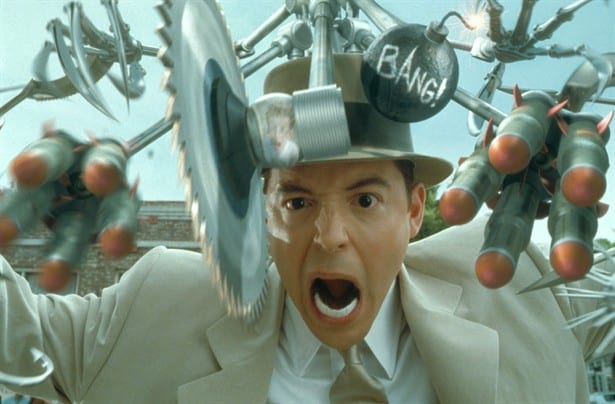Researchers shook the Internet by the brain this week when they partially restored a quadriplegic man’s control of his hand, and we saw a glimpse of a potentially game changing brain-machine interface.
Battelle‘s and The Ohio State University Wexner Medical Center’s amazing advancement comes in the medical field. But my first thought following “Awesome” was just short of “that would make a nice accessory for my iPhone.”
It’s not such a shallow thought. Brain-machine interfaces aren’t just for special cases. Not in theory. Researchers have been trying to figure out how to control electronics with our brains for years. They’ve even succeeded in various ways, including wireless means.
Science Fact Friday champions today’s advancements that could turn yesterday’s Science Fiction into tomorrow’s science reality. Information presented here is for entertainment purposes only. We are not liable if your space elevator collapses.
Skip to the List: 5 Totally Plausible Brain-Machine Interfaces from Sci-Fi
Demonstrated here below is the brain-machine interface (or brain-computer interface, BCI) that made such a buzz. It’s called Neurobridge. Afterward, we’ll get into more specifics about how it works. For now, picture the Na’vi in Avatar. Except, it’s a PC and not a tree or hair-braid or whatever.
How It Works
The Neurobridge (awesome infographic by The Washington Post) doesn’t read thoughts or anything. It’s just interpreting data sent by a chip embedded in the patient’s motor cortex. Right now, as you can see in the video, the patient is physically tethered. Decoding software does its thing, then sends it to a forearm cuff (in this case) containing electrodes.
Battelle and OSU aren’t the only ones working on this kind of technology, and their methods aren’t the only available. Really, any accurate measuring of brain functions could conceivably be turned into data for software to interpret, right?
This is just one step, although a very big step, in the field of neuroprosthetics. There is research underway elsewhere into restoring limited sight to the blind. The basic idea being a sensor “sees” a color such as red, then triggers an implant to activate the part of the brain that displays red. And then there’s things like this brain-controlled helicopter.
So what does all this mean for the future? What strange visions might come true? Well, using science fiction as our guide, let’s take a look at…
5 Totally Plausible Brain-Machine Interfaces from Sci-Fi
5) The Matrix
If you only glanced at it, you might believe the fella in the above video was learning karate from Laurence Fishburne instead of trying to move his arm.
This is the most outlandishly extrapolated claims on this list. Out of them all, it’s the least plausible even with awesome advancements like the Neurobridge. Seeing the Matrix, to me, is the biggest obstacle. It’s a little more than just seeing a color.
For fun, let’s assume that hurdle could be cleared. It was possible to induce a cybernetic hallucination/virtual reality like The Matrix. Pretend we’re the evil machines for a moment. In a hundred years or so, if the humans keep tinkering like they do, we will have tools that could measure exactly what movement our prisoners/foodstock wanted to make. We could know if they wanted to walk or run, and we could move the world around them to create the necessary illusion.
Kind of scary. But it could also be non-evil machines. It could be the 22nd-century version of a couch potato gamer, jacking himself into a virtual reality that offers complete immersion. Not so scary.
4) Cybermen (Doctor Who)
I included Doctor Who’s Cybermen on the list to represent our apprehension over partnering our brains with computers.
We don’t want to become Cybermen. The part of you that agrees with that statement, assuming you’re a Whovian, is the part of you that recoils a bit when you think of brain-machine interfaces. It’s natural, I’m assuming. I don’t believe Freud or Jung wrote about Cybermen.
The process to become a Cyberman is pretty irreversible, similar to how those who are resistant to change feel about technology’s forward march. Boogeymen in science fiction can represent resistance to change as much as they forewarn against actual impending doom. And, indeed, it’s a scary prospect to have any surgery performed on the noggin.
But in the future, procedures could become less and less invasive. Y’know. Not so much on the humanity killing.
3) Inspector Gadget
Okay, okay. So… Inspector Gadget is a joke.
I don’t mean I listed him comically. He’s literally a joke. Not only does it seem like he can’t control any of his hybrid parts, he’s a klutz when he does.
But what if, in some kind of alternate reality where cartoons from the ’80s are written by the guy who wrote True Detective (Nic Pizzolatto), Inspector Gadget is just the first human experiment of a new transhuman police force. What if, in this alternate reality, Inspector Gadget helps ushers in an all-robot era of martial law by being its guinea pig.
In all seriousness, I’d pay to see Christian Bale star in a gritty reboot. But even without the dark undertones, Inspector Gadget is an iconic cyborg. It awakened many of us to the concept of human augmentation, in a way that didn’t cause night terrors.
While most of the Inspector’s accessories are superfluous, some kind of hybrid is surely a goal, and we could see some experimental cases that make us exclaim, “Wowsers.”
2) Anakin and Luke Skywalker (Star Wars)
From General Grievous to Luke Skywalker, Star Wars is the gold standard for prosthesis in science fiction, in terms of “we want this to happen.”
Aside from the access panel, Luke’s hand appears virtually indistinguishable from a normal hand.
And Anakin, who for The Chosen One sure lost a lot of body parts in combat, eventually becomes more machine than man while maintaining damn fine mobility.
All of the cybernetic prosthetics are controlled with thought, seemingly. This is actually the most plausible on the list, in my opinion, because it seems to be only a matter of improving the appearance and control.
1) RoboCop
Like I wouldn’t go to the most awesome of them all.
And I’m not even talking about pistol-firing RoboCop. Just normal cop Alex Murphy.
His life is saved from a fatal wound during the line of duty, but technology saves him and makes him even stronger than before. (Almost as if they spent six million dollars on dollars on him).
This says it all. Think of all the service men and women this kind of technology could help. Hell, they’d also have jobs waiting for them, as Super Cops.
Conclusion
Looking ahead, who knows how long any of this will actually take to become common place. Hopefully, Cybermen will never get there.
It won’t be just one field. It will be a confluence. If you remember from Science Fact Friday’s former home, super materials could help simultaneously shrink and improve sensors. And as we’ll talk about in future Science Fact Fridays, the singularity could mean giving up the “brain” part altogether.
Like Fictionphile on Facebook for future Science Fact Fridays. Be sure to let me know in the comments below what fiction you think could become fact. Ghost in the Shell? Fullmetal Alchemist?




